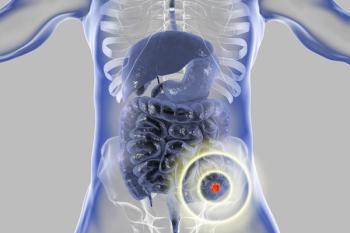
Oncology NEWS International
- Oncology NEWS International Vol 7 No 4
- Volume 7
- Issue 4
Virtual Colonoscopy a ‘Kinder, Gentler’ Colon Exam
COLUMBUS, Ohio--Although virtual colonoscopy is a new and still evolving technology, it could one day prove to be more convenient and less expensive than traditional methods of colon cancer screening, said David J. Vining, MD, assistant professor of diagnostic radiology, Wake Forest University School of Medicine, Winston-Salem, North Carolina.
COLUMBUS, Ohio--Although virtual colonoscopy is a new and still evolving technology, it could one day prove to be more convenient and less expensive than traditional methods of colon cancer screening, said David J. Vining, MD, assistant professor of diagnostic radiology, Wake Forest University School of Medicine, Winston-Salem, North Carolina.
Indeed, one major advantage of virtual colonoscopy is that its noninvasive nature may increase the publics willingness to be screened for colon cancer, Dr. Vining said at the Ohio State University-James Cancer Hospital and Research Institute 4th Annual Oncology Update. "Were trying to develop a kinder, gentler bowel exam," he said in an interview with Oncology News International.
Virtual colonoscopy is the marriage of volume imaging procedures, such as helical computed tomography, ultrasound, or magnetic resonance imaging, and the state-of-the-art computer technology known as virtual reality.
Virtual colonoscopy procedures can be performed in less than a minute, are minimally invasive, and carry little risk. For these reasons, its use as a screening procedure may be more attractive to the public than either fiberoptic colonoscopy or barium enema, Dr. Vining said. The cost of virtual colonoscopy, although not yet established, would also likely be lower than that of conventional bowel exams. Dr. Vining estimated it could be performed for about $500.
Virtual colonoscopy also offers clinical advantages over fiberoptic colonos-copy. It can cross obstructing lesions and can always reach the cecum. It can also determine the degree of wall invasion when a neoplasm is found.
In addition to providing a novel way of viewing the colon, computer-assisted diagnosis software is capable of identifying polyps, small lesions, and other abnormal tissue. It does this by targeting the locations of abnormal wall thickness or polyps shapes and then reporting back to the physician.
"I think this feature, known as computer-assisted detection, is a hot area," Dr. Vining said. "It might be used by physicians as either a first screening or a second reading."
Numerous reports on virtual endos-copy were presented at a recent Radiological Society of North America conference, Dr. Vining said. Mayo Clinic researchers reported that in 70 patients with colon polyps 10 mm or larger, virtual endoscopy achieved 71% sensitivity and 79% specificity, he said.
Despite its potential, the technology is still in its infancy, Dr. Vining emphasized. Clinical trials are just now underway at Wake Forest University, and FDA clearance for colorectal screening indications still awaits.
Although virtual colonoscopy procedures vary by institution, the basic technique involves four steps, some of which are identical to those used in fiberoptic colonoscopy. The following procedure is the one used by Dr. Vinings group.
First, the patients colon is cleansed using cathartic agents. Next, the colon is inflated with carbon dioxide gas. In the third step, the physician scans the colon with helical CT. Finally, a computer uses the CT imaging information to generate a virtual reality image of the colon.
The result is a three-dimensional (3D) picture of the colon presented on a computer monitor (see figure). The physician controls how the picture is presented and the speed with which the entire length of the colon is traveled. Viewed with the images passing slowly, the colon can be inspected carefully. Viewed with the images passing quickly allows observers to feel as if they are actually flying through the colon.
The direction of travel is controlled by pointing a mouse cursor. Observers can face either forward or backward inside the colon. To prevent viewers from getting lost, the software provides a separate window on the screen with an overhead view of the path of navigation. Another feature can make the colon wall semi-transparent, which allows the physician to better examine hidden abnormalities.
Dr. Vining offered several tips for optimizing the 3D rendering. His team uses helical CT rather than conventional CT in order to eliminate respiratory motion. Other recommendations include the use of thin, 3 mm to 5 mm slices during CT scanning and use of overlapping reconstruction intervals of 1 mm. For accurate scans, it is also important that the patients bowels be thoroughly cleansed.
One of the biggest drawbacks of virtual colonoscopy is its inability to reproduce the appearance of the actual mucosa. Conventional colonoscopy allows the physician to see the color changes in the mucosa that can signal the location of a small lesion. Virtual colonoscopy lacks such visual cues.
To overcome this disadvantage, he said, the development of a tissue-contrast agent is needed. Ideally, this agent would be absorbed or secreted differently between normal and abnormal bowel.
Additional improvements would include more powerful and affordable computers, and faster and higher-resolution scanners, Dr. Vining said. Faster scanners, which will become available in the next year, will reduce scanning time from 30 to 60 seconds to 10 to 20 seconds.
Articles in this issue
over 27 years ago
New NCCN Outcomes Data Base Sparks Great Interestalmost 28 years ago
ODAC Recommends Approval of Two New Taxol Indicationsalmost 28 years ago
Research into Neuropathic Pain Yields Potential Therapiesalmost 28 years ago
Vice President Gore Is Featured In Antismoking Radio Spotsalmost 28 years ago
Genetically Modified Dendritic Cells Enhance Immune Responsealmost 28 years ago
Research Sets Stage for Possible Autoimmune Therapyalmost 28 years ago
Proposed Stark II Regulations Spell Trouble for Oncology Carealmost 28 years ago
Optimal Salvage Therapy for Ovarian Cancer Focus of ICACTalmost 28 years ago
Ten-Year Study of Survival Rates for Ovarian Canceralmost 28 years ago
Tamoxifen: Dramatic Decrease in Breast CancerNewsletter
Stay up to date on recent advances in the multidisciplinary approach to cancer.
































































































